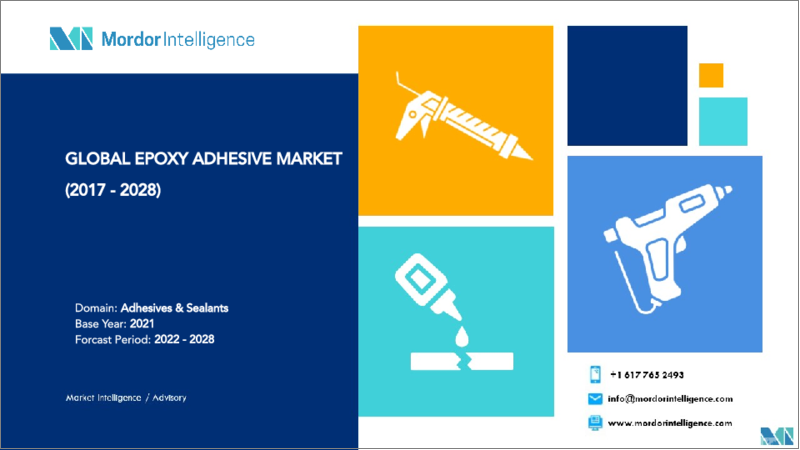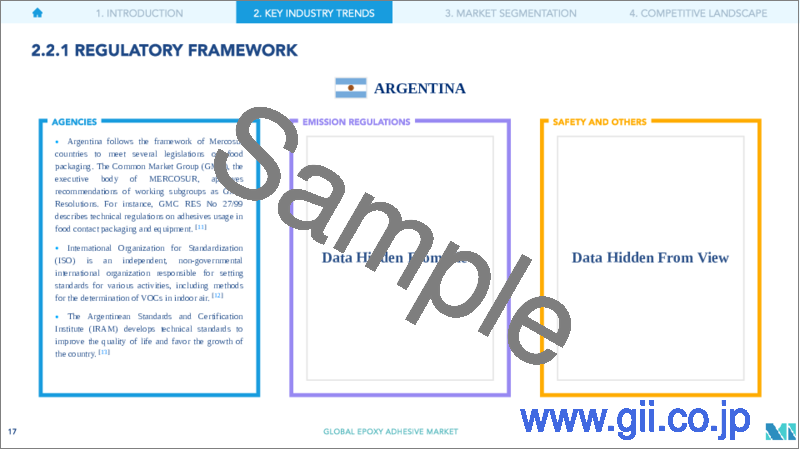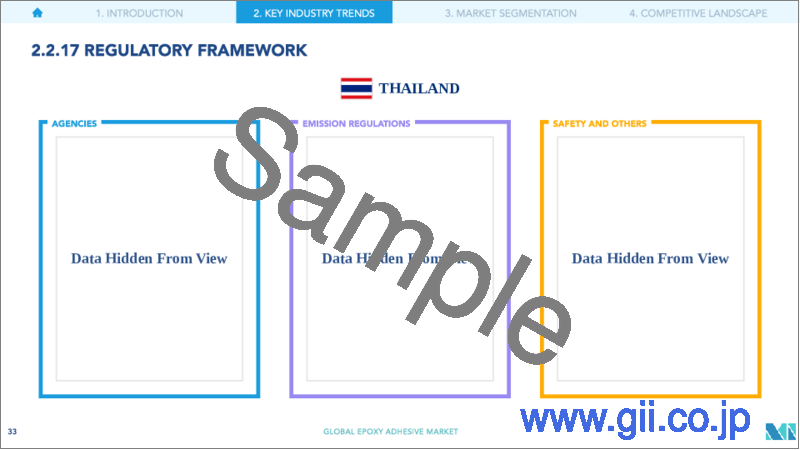|
|
市場調査レポート
商品コード
1188820
エポキシ接着剤の世界市場-2028年までの市場規模、シェア、予測Global Epoxy Adhesive Market - Size, Share & Forecasts up to 2028 |
||||||
|
● お客様のご希望に応じて、既存データの加工や未掲載情報(例:国別セグメント)の追加などの対応が可能です。 詳細はお問い合わせください。 |
|||||||
価格
| エポキシ接着剤の世界市場-2028年までの市場規模、シェア、予測 |
|
出版日: 2023年01月18日
発行: Mordor Intelligence
ページ情報: 英文 330 Pages
納期: 2~3営業日
|
ご注意事項 :
本レポートは最新情報反映のため適宜更新し、内容構成変更を行う場合があります。ご検討の際はお問い合わせください。
- 全表示
- 概要
- 目次
概要
エポキシ接着剤の世界市場はCAGR6.40%を記録すると予測されます。
主なハイライト
- エンドユーザー業界別最大セグメント-自動車: 自動車は、構造接着や組み立て作業など幅広い接着剤の用途があるため、エンドユーザー業界では圧倒的な存在感を示しています。
- 技術別最大セグメント:反応型:自動車、木工・建具、建築・建設など、主要なエンドユーザー産業で幅広い用途に使用されている反応型が市場最大の技術タイプとなっています。
- 地域別最大セグメント:アジア太平洋:インド、中国、韓国、日本を中心とするアジア太平洋地域は、いくつかのエンドユーザー分野で使用されていることから、エポキシ接着剤の主要消費地となっています。
- アジア太平洋地域:中国、インド、韓国、日本などの国々では人口の増加と急速な都市化が進んでいるため、アジア太平洋地域は予測期間中に最も急速に成長する地域セグメントとなると予想されます。
主な市場動向
エンドユーザー産業別では、自動車が最大のセグメントとなっています。
- エポキシ樹脂系接着剤は、床材、屋根材、木製部品の接合部など、建設産業での用途が多いため、建設産業で広く使用されています。世界の建設産業は、2030年まで年率3.5%で成長すると予測されています。また、中国、インド、米国、インドネシアが建設業全体の58.3%を占めると予想されています。その結果、エポキシ接着剤の世界市場シェアにおいて、建築用シーリング材が金額ベースで18%近くを占めています。
- エポキシ樹脂系接着剤は、ガラス、金属、プラスチック、塗装面などの表面に適用可能で、その特徴は強力な接着力、耐久性、長寿命など自動車産業で役立っているため、広く使用されています。これらの製品は、エンジンや自動車のガスケットなどに使用されています。自動車産業における電気自動車分野は、成長国での需要増加により、予測期間において世界的にCAGR17.75%を記録すると予想されています。このため、自動車用エポキシ接着剤の需要は予測期間中に増加すると予想されます。
- エポキシ接着剤は、センサーやケーブルの接着に使用できるため、電子・電気機器製造に広く使用されています。世界の電子機器産業と家電産業は、それぞれ2.51%と5.77%のCAGRで推移すると予想され、これが2022-2028年の予測期間におけるエポキシ接着剤の需要増につながると考えられています。
- エポキシ樹脂系接着剤は、ヘルスケア産業において、医療機器部品の組み立てや接着などの用途で使用されています。世界のヘルスケア投資の増加が、予測期間中の需要増につながると思われます。
地域別ではアジア太平洋地域が最も大きな割合を占めています。
- エポキシ系接着剤は、主にエポキシ樹脂と硬化剤から構成されています。2液型エポキシ接着剤は、エポキシ成分と硬化剤を別々に包装したものです。2つの成分を組み合わせると、すぐに硬化します。室温硬化型の2液型エポキシ接着剤は、ほぼ全ての製品があります。エポキシ樹脂と硬化剤を含む全ての配合成分をあらかじめ混合して、一液型のエポキシ接着剤とします。エポキシ接着剤は様々な被着体によく接着し、金属、ガラス、コンクリート、セラミックス、木材、多くのポリマーを接着することができます。硬化収縮は極めて小さいです。硬化したエポキシ樹脂の架橋化学構造は強固であり、構造接着用途に適しています。様々なエポキシ樹脂と硬化剤を組み合わせることで、多様な用途のエポキシ接着剤が開発されています。
- エポキシ接着剤の世界の消費者は、アジア太平洋地域が約47%のシェアを持ちトップで、次いで北米が25%、欧州が23.5%、中東・アフリカが3.3%、南米が3.1%のシェアを持っています。建設活動の拡大や、地域全体でCOVID-19が大流行した後の販売増による自動車生産の増加が、エポキシ接着剤の成長を促す主な要因になると予想されます。
- エンドユーザー分野全体では、自動車がエポキシの世界の主要消費者で約30.7%のシェアを占めており、次いで建築・建設、ヘルスケア、航空宇宙、木工がそれぞれ約19.2%、10.2%、7%、6.6%のシェアで続いています。その他の最終産業は約28%です。持続可能性を高めるために電気自動車の導入が進んでいることから、エポキシ接着剤の需要は世界的に高まると予想されます。
競合情勢
エポキシ接着剤の世界市場は、上位5社で47.36%を占め、緩やかな統合が進んでいます。この市場の主要なプレーヤーは、3M、Arkema Group、H.B. Fuller Company、Henkel AG &Co.KGaAおよびSika AGです(アルファベット順)。
その他の特典
- エクセル形式の市場予測(ME)シート
- アナリストによる3ヶ月間のサポート
目次
第1章 エグゼクティブサマリー&キーファインディング
第2章 レポートの提供
第3章 イントロダクション
- 調査の前提条件と市場の定義
- 調査範囲
- 調査手法
第4章 主要な業界動向
- エンドユーザー動向
- 規制の枠組み
- バリューチェーンと流通チャネル分析
第5章 市場のセグメンテーション
- エンドユーザー産業
- 航空宇宙
- 自動車
- 建築・建設
- 靴・皮革
- ヘルスケア
- パッケージング
- 木工・建具
- その他のエンドユーザー産業
- 技術分野
- 反応性
- 溶剤系
- UV硬化型接着剤
- 水系
- 地域別
- アジア太平洋地域
- オーストラリア
- 中国
- インド
- インドネシア
- 日本
- マレーシア
- シンガポール
- 韓国
- タイ
- その他アジア太平洋地域
- 欧州
- フランス
- ドイツ
- イタリア
- ロシア
- スペイン
- 英国
- その他の欧州地域
- 中東・アフリカ地域
- サウジアラビア
- 南アフリカ共和国
- その他の中東地域
- 北米
- カナダ
- メキシコ
- 米国
- 北米の残りの地域
- 南米地域
- アルゼンチン
- ブラジル
- その他の南米地域
- アジア太平洋地域
第6章 競合情勢
- Key Strategic Moves
- 市場シェア分析
- Company Landscape
- 企業プロファイル
- 3M
- Arkema Group
- H.B. Fuller Company
- Henkel AG & Co. KGaA
- Hubei Huitian New Materials Co. Ltd
- Huntsman International LLC
- Illinois Tool Works Inc.
- Jowat SE
- Kangda New Materials(Group)Co., Ltd.
- KLEBCHEMIE M. G. Becker GmbH & Co. KG
- MAPEI S.p.A.
- NANPAO RESINS CHEMICAL GROUP
- Pidilite Industries Ltd.
- Sika AG
- Soudal Holding N.V.
第7章 CEOへの主な戦略的質問
第8章 付録
- 接着剤とシーラントの世界産業概要
- 概要
- ポーターのファイブフォースフレームワーク
- 世界バリューチェーン分析
- 促進要因、抑制要因、および機会
- 情報源と参考資料
- 表と図のリスト
- プライマリーインサイト
- データパック
- 用語集
目次
Product Code: 92473
The Global Epoxy Adhesive Market is projected to register a CAGR of 6.40%
Key Highlights
- Largest Segment by End User Industry - Automotive : Automotive is the dominant end-user industry owing to the wide range of adhesive applications for structural bonding and assembly operations.
- Largest Segment by Technology - Reactive : Reactive is the largest technology type in the market owing to its wide range of applications across major end-user industries, including automotive, woodworking & joinery, and building & construction.
- Largest Segment by Region - Asia-Pacific : Asia-Pacific, mainly driven by India, China, South Korea, and Japan, is a major consumer of epoxy adhesive owing to its usage in several end-user segments.
- Fastest-growing Segment by Region - Asia-Pacific : Due to the increasing population and rapid urbanization in countries such as China, India, South Korea, and Japan, the Asia-Pacific region is projected to be the fastest-growing regional segment during the forecast period.
Key Market Trends
Automotive is the largest segment by End User Industry.
- Epoxy resin-based adhesives are widely used in the construction industry because of their applications in the construction industry, such as for flooring, roofing, wooden components joinery, etc. The construction industry globally is expected to grow at 3.5% per annum up to 2030. China, India, the United States, and Indonesia are expected to account for 58.3% of the overall construction growth globally. As a result, construction sealants account for a nearly 18% share of the global epoxy adhesive market share by value.
- Epoxy resin-based adhesives are widely used in the automotive industry because of their applicability to surfaces such as glass, metal, plastic, painted surfaces, etc., and their features are helpful in the automotive industry, such as for strong bonding, durability, and long-lasting. These products are used in engines and car gaskets. The electric vehicles segment of the automotive industry is expected to record a CAGR of 17.75% globally in the forecast period because of the increased demand for the same in growing economies. This is expected to increase the demand for automotive epoxy adhesives in the forecast period.
- Epoxy adhesives are widely used for electronics and electrical equipment manufacturing as they can be used for sticking sensors and cables. The global electronics and household appliances industries are expected to record CAGRs of 2.51% and 5.77%, respectively, which is expected to lead to an increase in demand for epoxy adhesives in the forecast period 2022-2028.
- Epoxy resin-based adhesives are used in the healthcare industry for applications such as assembling and bonding medical device parts. The increase in healthcare investments worldwide will lead to an increase in their demand in the forecast period.
Asia-Pacific is the largest segment by Region.
- Epoxy adhesives are made up largely of epoxy resin and a curing agent. Two-component epoxy adhesives are made by separately packaging the epoxy and curing agent components. They cure quickly after combining the two components. Almost all two-component room-temperature cure epoxy adhesives are available. All formulated components, including epoxy resin and curing agent, are mixed in advance to make one-component epoxy adhesives. Epoxy adhesives adhere well to various substrates and can be used to attach metals, glass, concrete, ceramics, wood, and many polymers. Curing shrinkage is extremely minimal. The cross-linked chemical structure of cured epoxy resin is strong and rigid, making it appropriate for structural bonding applications. Various epoxy adhesives for diverse uses have been developed by combining various epoxy resins and curing agents.
- Asia-Pacific is the top consumer of epoxy adhesives globally, holding a share of about 47%, followed by North America, Europe, Middle East and Africa, and South America, with shares of 25%, 23.5%, 3.3%, and 3.1%, respectively. Growing construction activities and the rising production of automotive vehicles due to an increase in sales after the COVID-19 pandemic across the region is expected to be the major factor driving the growth of epoxy adhesives.
- Across all the end-use sectors, automotive is the leading consumer of epoxy globally, holding a share of about 30.7%, followed by building and construction, healthcare, aerospace, and woodworking, with shares of about 19.2%, 10.2%, 7%, and 6.6%, respectively. The other end-use industries segment holds about 28%. The rising adoption of EVs to increase sustainability is expected to boost the demand for epoxy adhesives globally.
Competitive Landscape
The Global Epoxy Adhesive Market is moderately consolidated, with the top five companies occupying 47.36%. The major players in this market are 3M, Arkema Group, H.B. Fuller Company, Henkel AG & Co. KGaA and Sika AG (sorted alphabetically).
Additional Benefits:
- The market estimate (ME) sheet in Excel format
- 3 months of analyst support
TABLE OF CONTENTS
1 EXECUTIVE SUMMARY & KEY FINDINGS
2 REPORT OFFERS
3 INTRODUCTION
- 3.1 Study Assumptions & Market Definition
- 3.2 Scope of the Study
- 3.3 Research Methodology
4 KEY INDUSTRY TRENDS
- 4.1 End User Trends
- 4.2 Regulatory Framework
- 4.3 Value Chain & Distribution Channel Analysis
5 MARKET SEGMENTATION
- 5.1 End User Industry
- 5.1.1 Aerospace
- 5.1.2 Automotive
- 5.1.3 Building And Construction
- 5.1.4 Footwear And Leather
- 5.1.5 Healthcare
- 5.1.6 Packaging
- 5.1.7 Woodworking And Joinery
- 5.1.8 Other End-user Industries
- 5.2 Technology
- 5.2.1 Reactive
- 5.2.2 Solvent-borne
- 5.2.3 UV Cured Adhesives
- 5.2.4 Water-borne
- 5.3 Region
- 5.3.1 Asia-Pacific
- 5.3.1.1 Australia
- 5.3.1.2 China
- 5.3.1.3 India
- 5.3.1.4 Indonesia
- 5.3.1.5 Japan
- 5.3.1.6 Malaysia
- 5.3.1.7 Singapore
- 5.3.1.8 South Korea
- 5.3.1.9 Thailand
- 5.3.1.10 Rest Of Asia-Pacific
- 5.3.2 Europe
- 5.3.2.1 France
- 5.3.2.2 Germany
- 5.3.2.3 Italy
- 5.3.2.4 Russia
- 5.3.2.5 Spain
- 5.3.2.6 United Kingdom
- 5.3.2.7 Rest Of Europe
- 5.3.3 Middle East & Africa
- 5.3.3.1 Saudi Arabia
- 5.3.3.2 South Africa
- 5.3.3.3 Rest Of Middle East & Africa
- 5.3.4 North America
- 5.3.4.1 Canada
- 5.3.4.2 Mexico
- 5.3.4.3 United States
- 5.3.4.4 Rest Of North America
- 5.3.5 South America
- 5.3.5.1 Argentina
- 5.3.5.2 Brazil
- 5.3.5.3 Rest Of South America
- 5.3.1 Asia-Pacific
6 COMPETITIVE LANDSCAPE
- 6.1 Key Strategic Moves
- 6.2 Market Share Analysis
- 6.3 Company Landscape
- 6.4 Company Profiles
- 6.4.1 3M
- 6.4.2 Arkema Group
- 6.4.3 H.B. Fuller Company
- 6.4.4 Henkel AG & Co. KGaA
- 6.4.5 Hubei Huitian New Materials Co. Ltd
- 6.4.6 Huntsman International LLC
- 6.4.7 Illinois Tool Works Inc.
- 6.4.8 Jowat SE
- 6.4.9 Kangda New Materials (Group) Co., Ltd.
- 6.4.10 KLEBCHEMIE M. G. Becker GmbH & Co. KG
- 6.4.11 MAPEI S.p.A.
- 6.4.12 NANPAO RESINS CHEMICAL GROUP
- 6.4.13 Pidilite Industries Ltd.
- 6.4.14 Sika AG
- 6.4.15 Soudal Holding N.V.
7 KEY STRATEGIC QUESTIONS FOR ADHESIVES AND SEALANTS CEOS
8 APPENDIX
- 8.1 Global Adhesives and Sealants Industry Overview
- 8.1.1 Overview
- 8.1.2 Porter's Five Forces Framework
- 8.1.3 Global Value Chain Analysis
- 8.1.4 Drivers, Restraints, and Opportunities
- 8.2 Sources & References
- 8.3 List of Tables & Figures
- 8.4 Primary Insights
- 8.5 Data Pack
- 8.6 Glossary of Terms
お電話でのお問い合わせ
044-952-0102
( 土日・祝日を除く )




